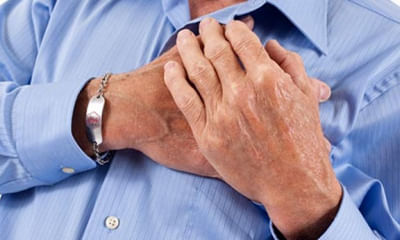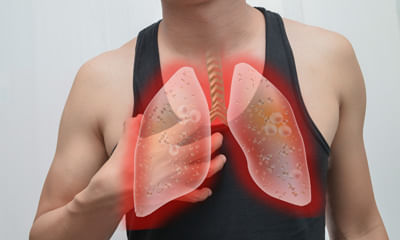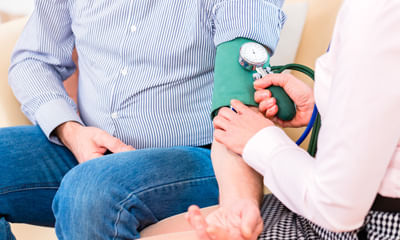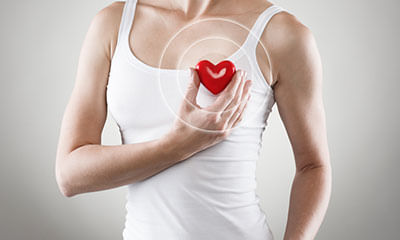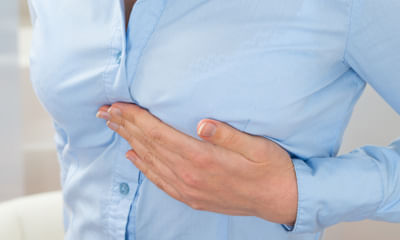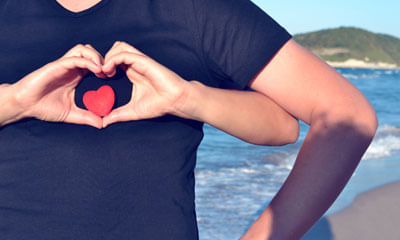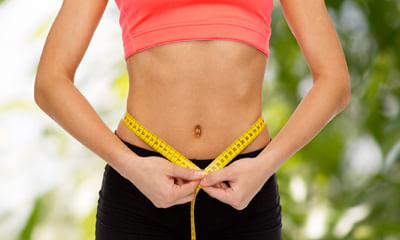Heart Rate After Climbing Stairs
My father age 69 years feeling chest pain when work or walk from last 7 days I have tested chest x ray, ecg chest x ray ...
Ask Free Question
Your father's symptoms are possible indication of "stable angina" stable angina is a heart disease which occurs only when body is stressed like walking or climbing stairs or other exercises. Ecg is typically normal in stable angina, it shows abnormality only during the periods of pain. I suggest you to go to a proper cardiologist, and do a treadmill test or stress echocardiography. Please keep tablet isosorbide mononitrate with yourself, whenever pain occurs, this tablet should be given. Do not swallow the tablet, it should be kept under the tongue. Please visit a cardiologist at the earliest.
My dad is 62, he got pain in chest, so his ecg and echo are normal but the tmt test shows positive tmt test, he didn't f ...
Ask Free Question
I am sorry to hear about your concern but will be happy to assist you. Mildly positive tmt means that there might be a blockage in the blood supply to the heart. And when the patient is running or climbing stairs or during exertion stress the heart is not getting sufficient blood supply. Let's connect over a call so that we can discuss your concern in details and make a suitable treatment plan for you.
Hello, I do hi it cardio and never feel winded. I can climb stairs easily. Yet sometimes my blood pressure shoots up. To ...
Ask Free Question
Hello lybrate-user, I am sorry to hear about your problem. Firstly, I would like to emphasize that you need to try and quit smoking. Smoking itself is a risk factor for hypertension. Your overall blood pressure is on the higher side. Your medications need to be increased and adjusted. If your ecg is normal then you probably don't have a heart attack. Please don't take sorbitrate as a routine medication if you don't have chest pain. Sorbitrate is not a medication for anxiety. Let us connect and try and formulate a holistic treatment plan for you. Thanks and regards.
Recently I felt my heart racing when I climbed stairs I felt as if my legs have gone weak I don't do any exercise. ...
Ask Free Question
Hi as per your query you should consult a cardiologist some tests are required eg ecg, echo and cardiac angiography, lipid profile.
I'm 22 years old female 163 cm height 63 kg weight approx. From 2 days I am facing palpitations, heart rate rises upto 1 ...
Ask Free Question
There are chances that in present these symptoms are not related to heart bu because of thyroid irregularities... Plus you have mentioned many bad habits in your routine which cause damage to your system if continued for long time.. For now you should make your routine proper.. Take proper treatment to cure thyroid (homoeopathic) You can consult me online for proper homoeopathic treatment.
I'm 22 years old female 163 cm height 63 kg weight approx. From 2 days I am facing palpitations while in rest and certai ...
Ask Free Question
hey please check thyroid profile again and keep on repeating every 3 months for proper dosing of thyroxine ..your palpitations are most probably sign for change in dosing of thyroxine
Sir I have weakness for last 2 month even while I am doing small work like climb stair my heart beat rise and always hav ...
Ask Free Question
You should also mention your age ,your status regarding diabetes or blood pressure etc .if you also feel pain in chest while walking please mention. If you you don't have above such symptoms then please check your hemoglobin, blood sugar level, thyroid level. And report accordingly.
I immediately got tired and overbreathed while doing any small job, like jogging, climbing stairs etc. Is it symptoms of ...
Ask Free Question
Get cbc esr and vitamin d3 test vitamin b12 checked and lipid profile test. Revert reports. Will guide you then.
Is 108bpm is good or bad. In my ecg report result shows sinus tachycardia. Is it normal or dangerous? ...
Ask Free Question
Sinus tachycardia means increased heart rate. I would like to convey here first heart rate is not a static one. It will be varying depending upon various factors like age, physical activity, hydration status, emotional status, personality type, familial and so on. The first thing you have to check is during the time of taking ecg were you undergoing any physical activity for example did you do ecg after climbing up stairs or may be you might have been anxious in front of a lady nurse with bare body or afraid of hospital atmosphere and so on. You can repeat ecg in a completely relaxed state in a relaxed environment and check. If still higher heart rate then you can go for routine blood test since lesser hemoglobin could cause tachycardia and infections can cause it. And later if needed you might have to do thyroid function tests. But before all these better do a consultation because after taking detailed history I can provide you a best solution. Feel free to have a private chat with me and get clarified. I am ready to help you out.
Hey. I am a girl. My age is just 19 and my weight is 70+ whereas my height is short. The main problem is in my thighs th ...
Ask Free Question
You need to have diet plan based on your bmi & activities. Whatever we eat is metabolised by the body for the energy needed to do daily work and the excess is stored as fat. Abdomen is the first place to gain weight and last to disappear. In brief, weight reduction can be achieved only by reducing the intake of food 1/3 of what you take now. And by appropriate exercise plans for each part like belly, thighs, legs / chest etc. To burn off fat. Some tips 1) drink three or four cups of water whenever you feel hungry and just before eating food 2) take boiled or raw vegetable like cucumber, carrot etc. As half of your diet. Then take 1/2 of your total diet as sprouted pulses / proteinaceous food like roti, cooked pulses and remaining with rice or other carbohydrates. Oil or ghee etc. Should be just bare minimum. And do aerobic exercises, running, jogging or at least walking briskly 3-5 kms and swimming if possible, and in a gym if feasible. The most important is to burn off the energy intake by exercises. There is no short cut or medicines without exercise & dieting to take just as mush food as needed for your activities. The food we eat is utilised for our energy needs and the remaining will be stored as fat which leads to obesity. It is better to do some tests. Diet chart timingfoods to eatcalories early morninglukewarm water with lemon 1 glass0 tea without sugar + 2 biscuits90 breakfast2 rotis + 1/2 cup paneer curry330 orbrown bread upma 1 plate + milk 1 cup300 mid-morning1 banana/1/2 cup melon/20 grapes50 lunchbrown rice 1 cup (195 gm) + mixed vegetables 1/2 cup + salad 1 bowl + raita 1 small bowl345 eveningbutter milk 1 cup35 dinner2 rotis + vegetable soup 1 bowl + salad 1 bowl370 total1220/1190 cal to lose weight, you must burn more calories than you consume a day from your diet, if you burn 3000 calories, you’ll lose a pound a week. Losing fat in the legs will improve your appearance and your health. Carrying too much fat slows you down and increases your risk of heart disease and diabetes. A weight-loss goal of 1 to 2 pounds a week is reasonable, which means in 30 days you can lose 4 to 8 pounds. Losing leg fat in 30 days requires a plan of healthy eating, cardiovascular workouts and leg toning exercises. Step 1 eat a healthy, low-calorie diet. Eating more calories than your body need leads to fat gain. Cut your calories by eliminating sugary and fatty foods from your diet. Measure your portion sizes to avoid overeating. The 2010 dietary guidelines for americans suggest eating fresh, healthy foods such as fruits and vegetables, whole grains and lean proteins such as poultry. Step 2 perform 30 to 60 minutes of cardiovascular exercise five days a week during the course of 30 days. Cardiovascular exercise burns fat speeding up the weight loss process over dieting alone. Consider doing exercises that also target the legs such as rollerblading, running, hiking and bicycling. Step 3 do squats two to three days a week over the month. The american council on exercise reports that squats along with lunges are the best exercises for thighs. Start by standing with your legs a little wider than hip-width. Bend your knees, shifting your weight back as if you're going to sit down. Don't allow your knees to extend over the toes. Straighten your legs to return to the start position. Add resistance by holding dumbbells or a barbell. Step 4 perform lunges two to three days a week for 30 days. Stand with your legs hip-width apart. Step forward with your right leg, bending the knee as shift your weight forward. Keep your right knee over the ankle. Push back with the right foot to return to the start position. If you have bad knees, step backward instead of forward into the lunge. Add resistance by holding a dumbbell in each hand. Perform the lunge to the side to target the adductors and abductors -- inner and outer thighs. Step 5 take the stairs instead of the elevator or escalator during the next 30 days. Using the stairs burns fat and tones the legs. It can also cut your risk of premature death by 15 percent. Tips •continue eating healthy and exercising beyond the 30 days to maintain your weight loss and health. How to reduce fat in the buttocks a sculpted, firm backside is the goal of many who seek to improve their appearance. Strong, lean buttocks are also a sign of health. Carrying too much fat increases your risk of heart disease and diabetes. Reducing fat in the buttocks requires lifestyle changes, including a healthy diet and exercise. Step 1 reduce calorie consumption to prevent gaining more fat. To lose 1 lb. Of fat, you need to reduce or burn 3,500 calories. Cut out junk food and monitor portion sizes. Don't restrict your diet too much or you may slow your metabolism. Medline plus warns that women shouldn't eat less than 1,200 calories a day. Men shouldn't eat fewer than 1,500 calories. Step 2 burn fat with regular cardiovascular exercise. The american heart association recommends at least 30 minutes of exercise five days a week to burn fat and improve heart health. Running, hiking and stair climbing burn calories, as well as firm up the buttocks. But you can perform any exercise that you enjoy and gets your heart rate up to burn fat in the backside. Step 3 perform butt lifts. Butt lifts are ideal for beginners or people who have bad knees and can't do squats or lunges. Lay on your back with your knees bent and feet flat on the floor. Squeeze your glutes to lift your buttocks off the floor. Release to return to the start position. Perform two sets of 12 to 15 repetitions. To increase resistance, hold a dumbbell, barbell or body bar over your hips. Step 4 perform reverse extensions on a stability ball. Like butt lifts, reverse extensions target the butt muscles without putting stress on the knees. Lay face down on the ball with your hands and feet on the floor. Shift your weight so that it's supported by your hands. Squeeze your glutes to lift your legs until they are parallel to the floor. Hold your legs together through the range of motion. Lower to the start position repeating two sets of 12 to 15 reps. Step 5 do squats. The american council on exercise reports that squats, along with lunges are the best exercise for firming up the buttocks. Stand with your feet slightly wider than your hips. Bend at the knees, pushing your hips back as if you're going to sit down. Your head and chest are lifted and your knees stay behind your toes. Return to the start position and repeat two sets of 12 to 15 reps. Add more resistance by holding dumbbells, a barbell or body bar, or using resistance bands. Step 6 take the stairs. Instead of using the elevator or escalator -- always use the stairs to burn fat and tighten the glutes. Things you'll need •dumbbells, barbell or body bar •resistance band •stability ball.

